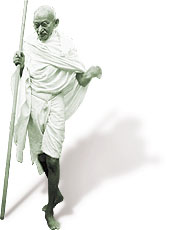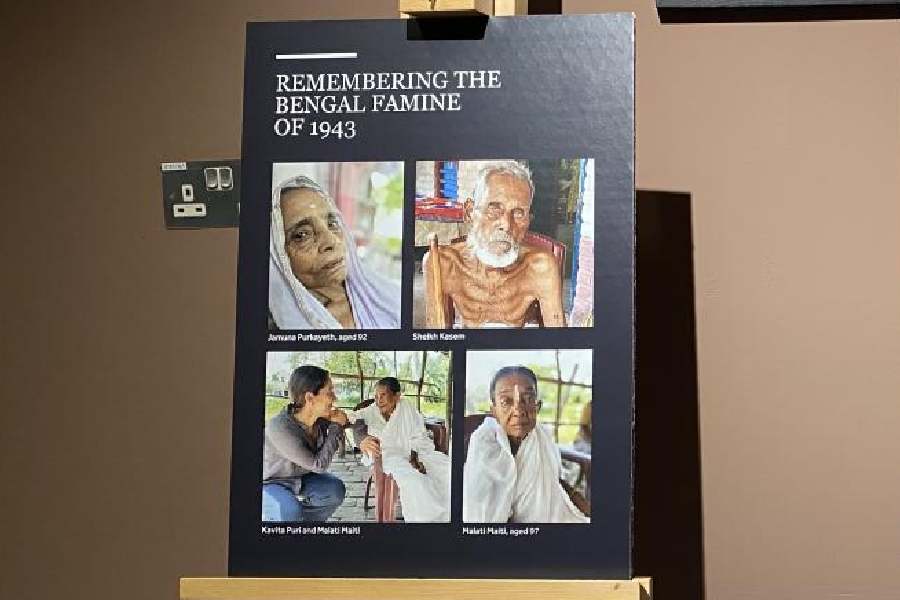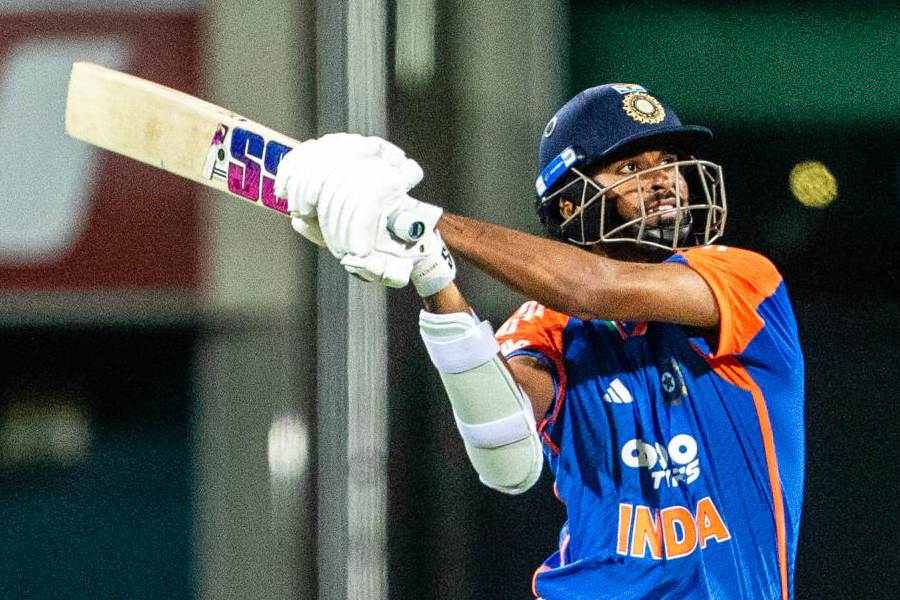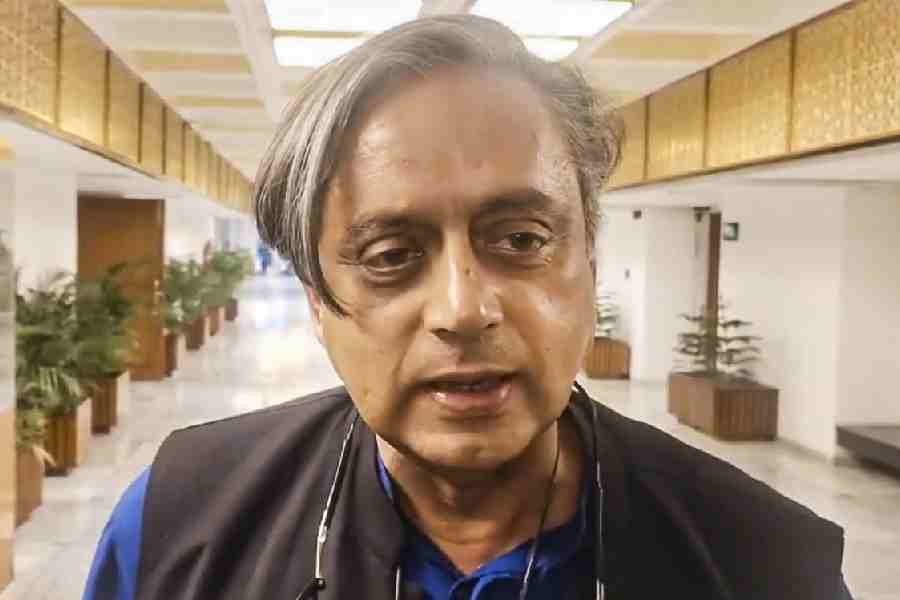 |
 |
| Wear the talk: Mahatma Gandhi (top); Atal Bihari Vajpayee in his trademark dhoti and kurta-pyjamas |
The Bharatiya Janata Party (BJP) has this little column on its official website that lets you peep into the mind of Prime Minister Atal Bihari Vajpayee — fondly, if clumsily, referred to by the content provider as the Man of India’s Destiny. Like all celebrities, Atal Bihari Vajpayee candidly lists his favourites in areas as diverse as food and films. He is fond of fish, he says, and likes the colour blue. His favourite film is Devdas and among his special friends is Lal Krishna Advani.
It’s the slot for clothes that showcases Vajpayee’s favourite dilemma: to be or not to be — secular, that is. His most preferred form of attire, he says, is a dhoti-kurta and, occasionally, a pathani suit.
Vajpayee has been in power for the last six years and is yet to be seen in a pathani suit — a loose salwar-kameez mostly worn by Pakistani men. And, going by his last few appearances at public meetings, even the dhoti is slowly being phased out. As Vajpayee travelled from West Bengal to Assam last week, he did so not in his branded short dhoti and kurta. Instead he wore a kurta and pyjamas with his now familiar blue waistcoat.
In some hopeful circles, Vajpayee’s switchover is being viewed as an affirmation of his secular credentials for, apart from khaki shorts, there is nothing that typecasts the Rashtriya Swayamsevak Sangh (RSS) more than a short dhoti. For the dhoti-lovers’ club, it is a betrayal of sorts. For Vajpayee’s friends, the shift to pyjamas underlines convenience. And while theories abound, the change has certainly been noticed — and is being talked about.
“I really can’t imagine Vajpayeeji wearing anything other than a dhoti,” says one of the campaign strategists of the BJP. “I just shot him extensively some days ago, and he was in his dhoti and kurta all through,” he says.
Prime Ministerial attire is often a political statement. Clothes may or may not make a man, but they can certainly make a point. Since the time khadi became a symbol of resistance to the time it turned designer, Indian politicians have, with their chosen clothes, worn their ideologies on their sleeves. Many believe that Jawaharlal Nehru — with his trademark rose on the lapel and achkan with tight churidars — spelt refined culture, just as Rajiv Gandhi’s white kurta-pyjamas and Lotto shoes underlined the two disparate worlds that he straddled.
Friends of V.P. Singh used to say that he was quirky about his pyjamas. When he was in trouble, as he frequently was during his short-lived tenure at the Centre, his pyjamas were tight — the tautness of the churidar, no doubt, reflecting the squeeze that he was in. When he was in control and in peace, the pyjamas were loose.
An old-timer recalls that of all Prime Ministers, it was Indira Gandhi who was the most particular about what she wore. In one election campaign, he remembers that she wore a simple cotton sari, the kind worn by tribal women of Uttar Pradesh, as she travelled through the interiors of the state. “The day she came back to Delhi, she had a public meeting lined up,” he says. “But instead of going straight to the venue of the meeting, she first went home and changed into a silk sari, the kind that city women wear,” he says.
When she went abroad, she dressed with style. In the United States, away from her opponents’ critical gaze, she often wore rich silks with sleeveless blouses. “Indira Gandhi was very particular about what she wore,” says a close associate of Atal Bihari Vajpayee who had also closely watched Gandhi during her days in power. “But Mr Vajpayee is different— he is not greatly particular about his clothes, but not indifferent either,” he says.
In fact, compared with the rest of the extended Sangh parivar, Vajpayee is occasionally even a little Bohemian when it comes to clothes. The parivar is a melange of three colours — white, khaki and saffron. Vajpayee, on the other hand, has been seen, in recent times, in different colours — and some say not just figuratively, but literally as well. He has waistcoats in seven or eight shades. On a recent visit to south-east Asia, he surprised his hosts — to say nothing of TV-viewers and newspaper-readers back home — by moving around in a batik bush-shirt. “For formal occasions he is mostly in a bandhgala. But he has also appeared in a T-shirt and trousers,” says a friend.
Now of course, as India and Pakistan get ready for a subcontinental embrace, the Prime Minister is waiting for a set of sherwanis to come in from Karachi. Pakistani designer Ameer Adnan plans to present Vajpayee with three sherwanis — complete with Kashmiri embroidery — after the Lok Sabha polls.
Apparently, Vajpayee had been suitably impressed by a sherwani a Pakistani protocol officer wore at the 2001 Agra summit. He complimented the officer, and rued that he had not worn a sherwani since the Seventies.
But one of the highlights of his attire during the Seventies was not the sherwani, but an achkan with a churidar. He wore this in 1977 when he addressed the United Nations General Assembly as India’s foreign minister.
But since he came to power at the Centre in 1998, it’s the kurta — with long sleeves, cuffed and buttoned at the wrist — and the dhoti that have together been a veritable part of Vajpayee’s image.
The dhoti, in fact, has had a long association with Indian politics. Ever since Mahatma Gandhi donned what the Concise Oxford Dictionary refers to as a “loincloth worn by male Hindus,” the dhoti has been a symbol of political India.
Gandhi’s tryst with the dhoti was an abiding one. Communist Party of India leader D. Raja points out that Gandhi had famously changed over to the dhoti after seeing a poor peasant at work in a village near Madurai. Once suited-and-booted, Gandhi started to shed his clothes as he moved from England to South Africa to India.
Calendars of the times portrayed world leaders — from Hitler and Mussolini to Stalin and Roosevelt — in full military regalia. Gandhi stood out among them as a man with a single piece of cloth tied around his waist.
“Of course, the dhoti helped him identify with the poor,” says historian Basudev Chatterjee. “But it also underlined his belief in the simplicity of life — a value that Gandhi believed had a lot more to offer than modern civilisation.” Not surprisingly, when Gandhi met the King of England in 1931, he did so in his dhoti.
“Mr Gandhi,” a reporter had then remarked. “Don’t you think you were a little under-dressed for the occasion?” Gandhi replied: “I think the King had worn enough for the two of us.”
If Gandhi wore a dhoti to make a political statement, B.R. Ambedkar shunned the cloth to drive home another point. For the Dalit leader, immortalised in a blue suit in squat statues across the north, the Western two-piece suit was a symbol of the aspirations of the marginalised poor. It was the same aspiration that Mayavati underlined when she wore what many thought were garish clothes and ornaments.
Unlike Sonia Gandhi — always impeccably dressed in traditional Indian saris and occasionally in salwar kameezes in muted colours — or her daughter Priyanka, resplendent in public in her bright handloom saris, Mayavati has never been seen as an elegant dresser. On her last birthday, when she wore a baby pink salwar kameez with glittering diamonds, she was derided by upper-caste India, but admired by her supporters for just that.
Clothes, clearly, have their constituencies, too. Gandhi’s dhoti said as much about his life, as his words and actions did. He wore his dhoti high, well above the knees, with the ends tucked comfortably behind. It’s a style that is still followed in many parts of India.
Politicians across the country continue to wear the dhoti, albeit in varying styles.
The bhadralok Bengali’s preferred form takes on a different dimension in the rest of India. In the south, it is worn as a white mundu — what the northerners refer to as a lungi — with a white shirt. In the east, politicians wear a dhoti with or without pleats. The dhoti is traditionally worn with a Gandhi cap in the West.
But in the North — especially in Delhi — the dhoti appears to be on its way out. Few, for instance, in Vajpayee’s Cabinet wear a dhoti. Jaswant Singh is in army fatigues with epaulettes, Arun Jaitley is mostly in trousers and Pramod Mahajan in pyjamas and kurta. “While leaders of the BJP may have no place for people of foreign origin, they are certainly open to clothes that come in from the West,” says a cynical observer.
Those who continue to wear a dhoti belong to the old school. Not surprisingly, Vajpayee’s two dhoti-wearing colleagues in the Cabinet — Murli Manohar Joshi and Lal Krishna Advani — are the blue-eyed boys of the RSS. Advani ties his dhoti in the Marwari style, which, an associate points out, is more comfortable and secure. “It looks elegant and gives him freedom of movement,” the Advani supporter says. “Vajpayee wears his dhoti in the Kashi style, which often reveals a lot of leg,” he adds.
But Vajpayee’s friends insist that the Prime Minister has not junked his dhoti this election for modesty or style, or to make a statement at a time when his party is busy wooing Muslims. “It’s nothing as complex as that,” says a confidant. “When he travels in a helicopter, he is more comfortable in a kurta and pyjamas — that’s all,” the friend states.
Vajpayee, party insiders emphasise, does not get a “sartorial brief” from his aides. His foster daughter, Namita, often advises him on what to wear, just as Advani’s daughter, Pratibha, and wife, Kamala, organise Advani’s clothes. “We think of attire as strategy only occasionally,” says the media strategist. In the last Assembly elections in Rajasthan, for instance, Vasundhara Raje had been advised by her team of experts to wear traditional Rajasthani costume. She did, and subsequently won the polls.
Elections are round the corner, and Vajpayee is in a kurta and pyjamas. Of course, he hasn’t bid goodbye to the dhoti yet. He wore one earlier this week at a press conference in New Delhi, and the BJP’s manifesto is replete with photographs of the PM in a dhoti. Like everything else with him, the kurta-pyjama is for a purpose, the dhoti for quite another. And one day, Vajpayee may just wear his favourite pathani suit.










